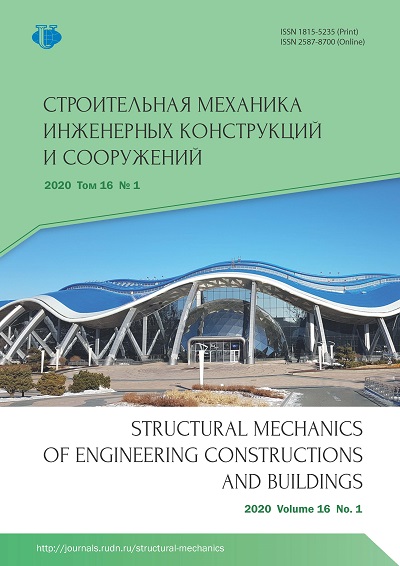Earthquake resistance analysis of structural systems of multi-storey civil buildings
- Authors: Abaev Z.K.1, Kodzaev M.Y.1, Bigulaev A.A.1
-
Affiliations:
- North Caucasian Institute of Mining and Metallurgy
- Issue: Vol 16, No 1 (2020)
- Pages: 76-82
- Section: Seismic resistence
- URL: https://journals.rudn.ru/structural-mechanics/article/view/23012
- DOI: https://doi.org/10.22363/1815-5235-2020-16-1-76-82
Cite item
Full Text
Abstract
Relevance. Increasing the density of urban population requires the use of optimal structural systems of multi-storey civil buildings, however, despite a large number of studies on the rationality of their application, the question of choosing an assessment of seismic resistance of structural systems of multi-storey civil buildings is still open. The aim of the study. This study aims to determine advantages and disadvantages of structural systems of multi-storey buildings in seismic areas. Methods. The results of comparison analysis of five structural systems (columns grid - 6×6 m, storey height - 3 m, number of storeys - 20) are presented in this article. The structural systems are: frame & tube, frame & core, core & walls, framed core & walls, framed core & tube. The calculation were done according to Building Code 14.13330.2018 for an earthquake of 8 points intensity of MSK-64 intensity scale. The SCAD Office software package was used for modeling and analyzing. The sum of the effective modal masses taken in the calculation was at least 90% of the total mass of the system excited in the direction of the seismic action for horizontal impacts and at least 75% - for vertical impacts. Results. The comparison was carried out according to the following criteria: maximum displacements, maximum compressive and tensile stresses, maximum periods of natural oscillations, maximum accelerations.
About the authors
Zaurbek K. Abaev
North Caucasian Institute of Mining and Metallurgy
Author for correspondence.
Email: abaich@yandex.ru
SPIN-code: 2843-1586
Candidate of Technical Sciences, Associate Professor of the Civil Engineering Department
44 Nikolaeva St., Vladikavkaz, 362021, Republic of North Ossetia - Alania, Russian FederationMarat Yu. Kodzaev
North Caucasian Institute of Mining and Metallurgy
Email: abaich@yandex.ru
SPIN-code: 7389-8508
Candidate of Technical Sciences, Associate Professor of the Department of Theoretical and Applied Mechanics
44 Nikolaeva St., Vladikavkaz, 362021, Republic of North Ossetia - Alania, Russian FederationAleksandr A. Bigulaev
North Caucasian Institute of Mining and Metallurgy
Email: abaich@yandex.ru
SPIN-code: 8764-6513
Candidate of Technical Sciences, Associate Professor of the Department of Theoretical and Applied Mechanics
44 Nikolaeva St., Vladikavkaz, 362021, Republic of North Ossetia - Alania, Russian FederationReferences
- Senin N.I. Ratsional'noe primenenie konstruktivnykh sistem mnogoetazhnykh zdaniy [Rational Usage of Structural Systems of Multi-Storey Buildings]. Vestnik MGSU. 2013;(11):76–83.
- Dzhinchvelashvili G.A., Bulushev, S.V. Feasibility evaluation for a predefined seismic resistance of structures. Structural Mechanics of Engineering Constructions and Buildings. 2018;14(1):70–79. http://dx.doi.org/10.22363/ 1815-5235-2018-14-1-70-79. (In Russ.)
- Aly A.M., Abburu S. On the Design of High-Rise Buildings for Multihazard: Fundamental Differences between Wind and Earthquake Demand. Shock and Vibration. 2015. doi: 10.1155/2015/148681.
- Liang S., Zou L., Wang D., Huang G. Analysis of three-dimensional equivalent static wind loads of symmetric high-rise buildings based on wind tunnel tests. Wind and Structures. 2014;19(5):565–583. doi: 10.12989/was. 2014.19.5.565.
- Iacovino C., Ditommaso R., Ponzo F., Limongelli M. The Interpolation Evolution Method for damage localization in structures under seismic excitation. Earthquake Engineering & Structural Dynamics. 2018;47(10):2117–2136. doi: 10.1002/eqe.3062.
- Laghi V., Palermo M., Trombetti T., Schildkamp M. Seismic-Proof Buildings in Developing Countries. Front. Built Environ. 2017;(3). doi: 10.3389/fbuil.2017.00049.
- Bai Y., Shi Y., Deng K. Collapse analysis of highrise steel moment frames incorporating deterioration effects of column axial force – bending moment interaction. Engineering Structures. 2016;(127):402–415. doi: 10.1016/ j.engstruct.2016.09.005.
- Lu X., Wang D., Wang S. Investigation of the seismic response of high-rise buildings supported on tensionresistant elastomeric isolation bearings. Earthquake Engineering & Structural Dynamics. 2016;45(13):2207–2228. doi: 10.1002/eqe.2755.
- Chapain S., Aly A.M. Vibration attenuation in high-rise buildings to achieve system-level performance under multiple hazards. Engineering Structures. 2019;(197):1–20. doi: 10.1016/j.engstruct.2019.109352.
- Mohaiminul H., Sourav R., Amit Ch., Elias Md., Iftekharul A. Seismic performance analysis of RCC with plan multistoried buildings irregularity. American Journal of Civil Engineering. 2016;4(3):68–73. doi: 10.11648/j.ajce.20160403.11.
- Moon K. Optimal structural configurations for tall buildings. Proceedings of the 13th East Asia-Pacific Conference on Structural Engineering and Construction, EASEC. 2013:354–355.
- Aydinoǧlu M.N. Challenges and Problems in Performance-Based Design of Tall Buildings. Geotechnical, Geological and Earthquake Engineering. 2014;(32):279–300.
- Jiang H.J., Lu X.L., Liu X.J., He L.S. PerformanceBased Seismic Design Principles and Structural Analysis of Shanghai Tower. Advances in Structural Engineering. 2014;17(4):513–527. doi: 10.1260/1369-4332.17.4.513.
- Schueller W. High-Rise Building Structures. New York, London, Sydney, Toronto: John Willey & Sons, Inc; 1977.
- Willford M., Whittaker A., Klemencic R. Recommendations for the Seismic Design of High-Rise Buildings. Council for Tall Buildings and Urban Habitat. 2008:1–28. doi: 10.13140/RG.2.1.2798.8085.
















